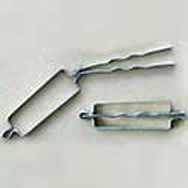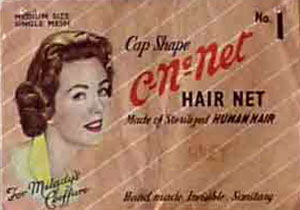Metal curlers for curling hair overnight 1920s, 30s and 40s

This page describes metal curlers, as used in the past for curling hair overnight. It is based on childhood observation and discussions with older people.
____
By the webmaster, based childhood observations in the 1940s
Discomfort in the cause of curly hair
Although rag curls are still well-known today, metal curlers are relatively unknown. The reason is not difficult to understand: They were designed to work overnight during the long hours of sleep, but were incredibly uncomfortable to sleep in. Nevertheless, throughout the 1940s that is what my mother used to do every night, even though her own mother had graduated to rag curls.
How to use a metal curler

Curling hair with metal curlers, screen shot from an old film. You can just see a ready-wound metal curler behind the curler being wound.
The end of a strand of hair around a couple of centimeters wide was placed between the two open metal prongs of the curler - see the top image. This gripped the strand. Then the prongs were closed to grasp the strand and the curler was turned over and over to wind the strand round the two prongs. Finally the prongs were bent back into the curler and secured in the slot shown on the left of the top image.
Comfort in metal curlers
Women tried to arrange metal curlers so that they didn't lie directly on them in bed. Where possible, they were fitted into the nape of the neck and close to the forehead.
How metal curlers affected women's hair styles
Comfort in bed with these curlers would explain the common hair styles in the mid-20th Century. Let me explain: My mother made her first curl by pulling all the hair on the top of her head forward and making a curler just above her forehead. Then she made other curls so that they would lie around her neck. Consequently the resulting curls were on the ends of uncurled, straight hair.
As a young child, I used to think that hair just grew that way - see the following examples which are edited screen shots from old films.




Common women's hair styles in the 1930s, 40s and 50s as a result of the placement of metal curlers which were hard to sleep on - hair mainly straight but curled at the ends
Hair nets
The curlers were generally kept in place overnight with a hair net. Even into the 1950s when I had a Saturday job serving in a department store, there was a regular call for them. The nets were made of a very fine thread-like mesh, held in shape with narrow thread-like elastic. They were available in a range of colours such that a net could match a natural hair colour and be almost invisible when worn. I say almost invisible. They flattened the hair which was fine for holding the overnight curlers in place, but during daytime, the flattening was obvious.

Hair net designed for daytime use, still in its original packet. Photographed in Nidderdale Museum.
The hair nets came in different thicknesses. The thin ones, described as 'invisible hair nets', were for daytime use - usually by older women.
Torn hair nets
contributed by Paulene Allett, a childhood recollection
Hair nets would get holes in them, so my mother often slept with two, arranged so that the holes in one were covered by the sound parts of the other.
| sources | webmaster | contact |
Text and images are copyright
If you can add anything to this page or provide a photo, please contact me.



